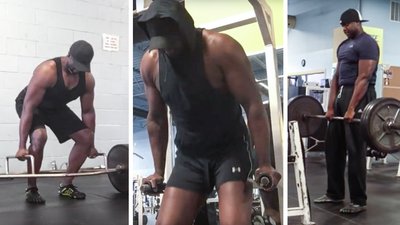In the gym, like elsewhere in life, being a tall and wide guy has advantages. But it also has…let's not call them "disadvantages," but rather, times "the norm" for smaller guys just won't work for you. When that happens, you can either try to make your body bend to someone else's rules—not recommended—or modify movements so they'll work better for you.
As a big and tall lifter myself—6-foot-4 and about 250—I get sick and tired of hearing that it's some form of copout or excuse to take leverages into account when training. Guess what: This isn't my opinion. It's eighth grade physics! When it comes to applying forces or moving loads, more work will always be needed to move the same load using a longer lever (i.e., a longer leg, arm, or spine) than a shorter one.
Translation: The bigger you are, the farther a weight has to move, and the more difficult it will be. To give a concrete example, a "normal" deadlift from the floor for one guy might basically be a three-inch deficit pull for you. As that image might help make clear, travelling more distance with a load will mean more stress and greater shear forces on the joints or regions that act as the fulcrum—think of the lower back in a deadlift, or the knees in a front squat.
Because of added joint stress to longer limbs, you'd be smart to employ a few modifications to make movements more favourable. Here are a few of my favorites.
Pressing: Use Fat Grips
The simple addition of an extra inch in bar width can have a remarkable number of positive effects. For one, an increase in bar thickness means a more even distribution of pressure throughout the palm of the hand, which can mean less joint stress through the elbow and shoulder. It seems like a very insignificant detail, but it translates to better-quality presses for anyone with longer arms and a greater distance to travel. Especially in compromised positions like the bottom of a bench, a dip, or a shoulder press, this modification can make for happier joints.
Here's a video of some dips using fat grips for added comfort.
The problem, of course, is that finding fat barbells and dumbbells is pretty hard if you don't belong to a strongman or powerlifting gym angled toward high-level performance. The answer in this case is to invest in your own pair of fat grips, which are relatively inexpensive but endlessly useful.
Most people focus on using these to improve grip strength during pulling movements (which they're also great for), but in the case of big and tall lifters, they should be considered mandatory for pressing, especially if you've got big hands to boot.
Sub the Barbell Bench Press for Pin Press
In my article "The 3 Rules of Upper-Body Training for Tall Guys," I touched on the importance of this movement, but it's worth mentioning again. Straight up: You've got long arms, and that usually wreaks havoc for movements with deep ranges of motion. In the case of chest work, shoulder stress may frustrate your ability to do full range of motion barbell bench presses, having you sub things out for dumbbells more often than you'd like.
To be fair, dumbbell pressing is a smart change and a very effective variation. But for 90 percent of lifters, it won't allow you to match your true totals and push your actual strength quite as effectively as using a barbell will.
With that said, the fixed hand position on a straight barbell means things will usually get sketchy in those last few inches of ROM at the bottom. Forfeiting those can mean salvation to your shoulders and allow you to push more absolute weight pain free. Here's why:
- You can kill the negative rep. That means more volume toward the actual "lifting" part of the lift, and less tax on the nervous system as a result of that.
- There's no real need for a spotter. The pins block the bar from crushing you, and if you can't lift the weight, then it just stays on the pins.
- Pushing from the safeties means you can't rely on the stretch reflex to take you out of the hole, meaning you'll work harder, and get better strength gains, from lighter weights.
- You can get closer to your true and absolute 1RM bench, which is something few can say they've ever accomplished using dumbbells.
Personally, I recommend using pin presses with a low-rep cluster set protocol, like I outline in my article "The Simple Strength Trick to Get the Most Out of Heavy Lifts." Since you're resting the bar on the safeties between reps anyway, this allows you to reset and position yourself for perfect, pain-free reps.
One more tip: If you hate all the attention you're bringing your way thanks to the noisy bar crashing down on the pins each rep, drape a couple of thin yoga mats over the pins to mute the sound. Problem solved.
Use Two Ropes for Face Pulls
If you've got long arms or you're very muscular, chances are a single rope on a pulley attachment doesn't give you the freedom of rotation you need to really benefit from face pulls. Muscular guys are often also tight through the shoulders, so having the hands too close together when pulling doesn't help their cause.
To involve the rear deltoids for the rotary component of this lift, you need to have a slightly wider hand position than, say, a row. The closer you can get to mimicking a double biceps pose, the better a "hit" you'll get for your rear deltoids during face pulls. That's why the simple hack of attaching two ropes to one pulley works like magic for long guys—and big, tight guys, too.
You've just doubled your radius and improved every rep of this great movement.
Start doing this right away. Your upper back and shoulders can thank me later.
Deadlifts: Try the Medium Sumo Stance and the Trap Bar
Seriously, these two movements may be the best friend your lower back ever had. For tall lifters, deadlifts usually pose the biggest challenge and threat to their safety. And understandably so! It's a long way up, and a pair of long legs can seriously block the ability to pull a heavy bar in a straight path to the top, free of dangerous compensations.
Instead of forcing a conventional deadlift style with a straight bar, acknowledge that your leverages aren't in your favor, and that injury is a much more serious possibility for you. If you've got long legs, a short torso, and less than fantastic mobility, you'll inevitably be putting your upper body behind the bar, which is not an optimal position for pulling strength.
Unlike a straight bar, the trap bar allows the shins to travel forward, which by extension allows the upper body to remain more vertical. The lower hip position improves quad activity and overall leg drive while maintaining a flat spine, and the weight is perfectly aligned with your center of gravity with no spinal contortions necessary.
For all these reasons, the trap bar deadlift is the bee's knees for many NBA strength coaches who want their athletes to pull heavy. Take a page out of their books and make the switch—preferably with my program in "The Best Damn Trap Bar Workout, Period"—and you'll be glad you did. And don't be afraid to use the high handles. You're still getting plenty of ROM, big guy.
Having said all that, if you're a stubborn lummox who can't breathe without barbell deadlifts and you think a trap bar is "faking it," do yourself a favor and at least modify your stance. Going for a medium sumo stance will lower your hip position and allow for some space to get the back tighter and keep the scapulae over the bar.
Don't Apologize for Your Size!
If you're big, train like it. Make accommodations for your size and length, and you'll be training pain free, and seeing gains all the same. We make adjustments for these things in regular life, and the same should be true in the gym. This is what will make you look imposing, but more importantly, allow you to train hard for the long haul, just like the small guys.

